“Smart” Vacuum Cleaners
An Audit Into The Security and Integrity of IoT Systems
Andrew Wong | UNSW Sydney
Today’s Agenda
- Thesis B plan
- Thesis B review
- Thesis B retrospective
- Thesis C revised plan
Statement
How have manufacturers of IoT / smart home devices addressed the increasing concerns of digital privacy and product security?
- Digital Privacy - Investigate the nature of network data (i.e. content, frequency, destination) and how the data is used.
- Product Security - Investigate potential security vulnerabilities and assess the effectiveness of current security fortifications.
Original Project Timeline
- Disassembly and analysis of firmware binaries to identify vulnerabilities
- inc. ADB binary functionality
- Search for unsecured secrets, logs, configurations
- Inspection of outbound internet traffic - security, PII, etc
- Inspection of local network traffic
- Inspection of interaction with nearby devices
- Protocol analysis
Thesis B in Review
More logging
Previously packet captures only logged WAN traffic…
- Now port mirroring from a switch (TP-Link TL-SG105E)
- Now getting all LAN data too! (port mirrored from AP)

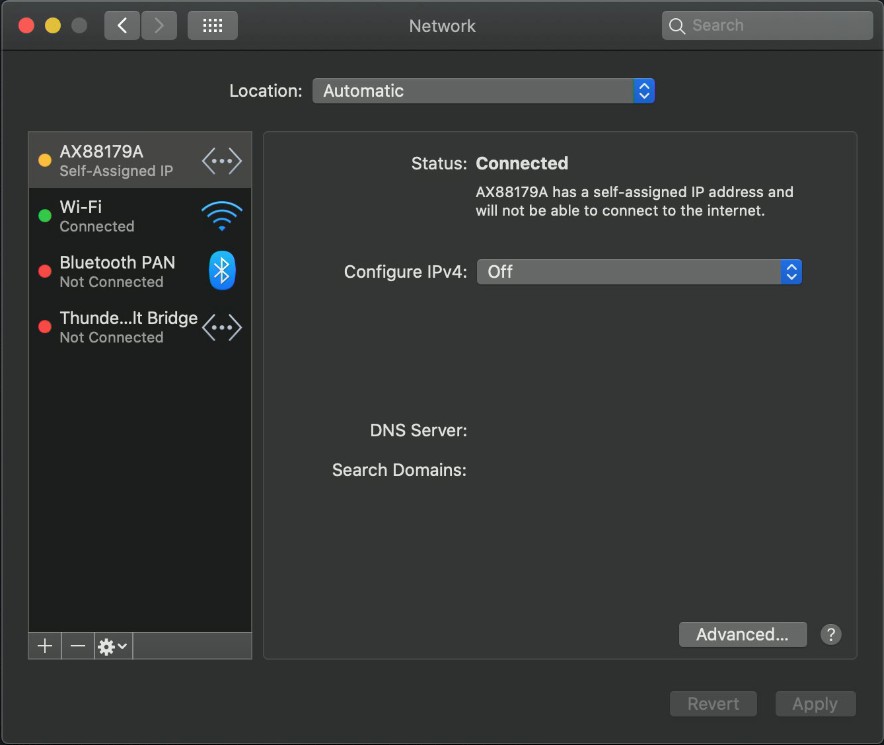

- The switch doesn’t have true port mirroring - also seeing sink traffic
- Disabled IPv4 and (attempt to disable) IPv6 on the network adapter
- Can filter out irrelevant packets later
Will later use dumps to check frequency and access
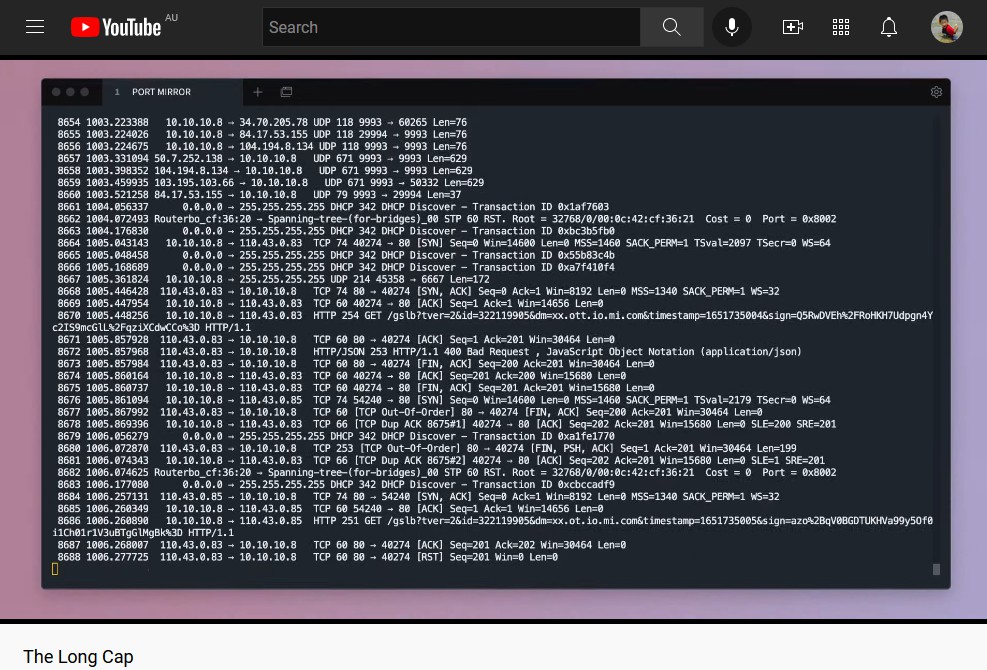
Speaking of packets…
🚩 WiFi credentials in plain text during setup
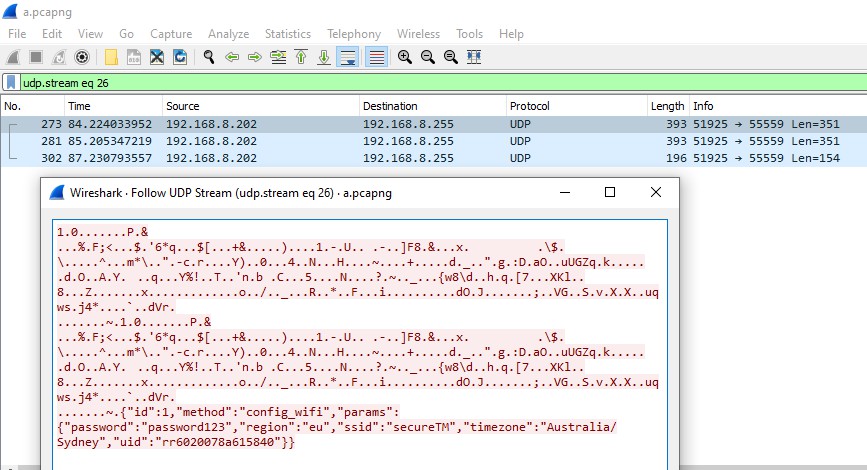
- Minor issue, only exploitable during time of setup
Fingerprinting
[ 0.340]U-Boot 2011.09-rc1-dirty (Mar 25 2020 - 20:45:43) Allwinner Technology
[ 0.000000] Linux version 3.4.39 (rockrobo@apimg) (gcc version 4.8.4 (Ubuntu/Linaro 4.8.4-2ubuntu1~14.04.1) ) #1 SMP PREEMPT Wed Mar 25 20:47:59 CST 2020
[ 0.000000] CPU: ARMv7 Processor [410fc075] revision 5 (ARMv7), cr=10c5387d
[ 0.000000] Machine: sun8i
...
CPU: Allwinner R16 (ARM Cortex-A7) - ARMv7l / armhf
ACU: STM32F103VCT6 (ARM Cortex-M3)
Roborock Firmware version: 3.5.4_1558
Operating system: Ubuntu 14.04.3 LTS

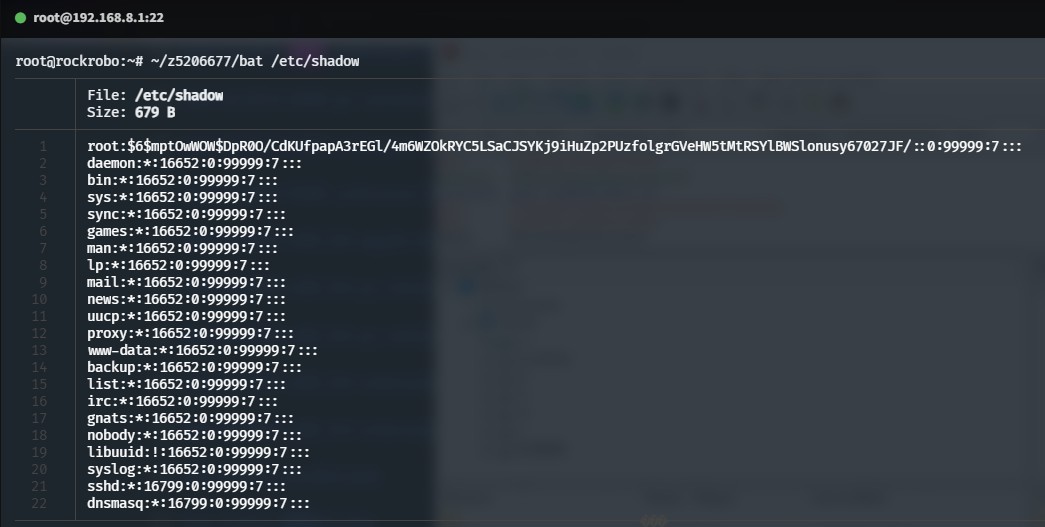
No additional users
root@rockrobo:~# ls /home
ruby
/home/ruby exists but no user ruby, though exists in /etc/passwd~
🚩 Everything is running as root

root@rockrobo:~# netstat -nltp
Active Internet connections (only servers)
Proto Recv-Q Send-Q Local Address Foreign Address State PID/Program name
tcp 0 0 127.0.0.1:54322 0.0.0.0:* LISTEN 991/miio_client
tcp 0 0 127.0.0.1:54323 0.0.0.0:* LISTEN 991/miio_client
tcp 0 0 0.0.0.0:22 0.0.0.0:* LISTEN 1644/sshd
tcp 0 0 127.0.0.1:55551 0.0.0.0:* LISTEN 998/rriot_tuya
tcp 0 0 0.0.0.0:6668 0.0.0.0:* LISTEN 998/rriot_tuya
tcp6 0 0 :::22 :::* LISTEN 1644/sshd
🚩 tcp/22 and tcp/6668 are exposed
🤷♂️ At least port 22 is blocked by iptables
root@rockrobo:~# iptables -L
Chain INPUT (policy ACCEPT)
target prot opt source destination
DROP udp -- anywhere anywhere udp dpt:6665
DROP tcp -- anywhere anywhere tcp dpt:6665
DROP tcp -- anywhere anywhere tcp dpt:ssh
Chain FORWARD (policy ACCEPT)
target prot opt source destination
Chain OUTPUT (policy ACCEPT)
target prot opt source destination
- What runs on port
6665player- What about file-based IPC?
root@rockrobo:~# ip6tables -L
Chain INPUT (policy ACCEPT)
target prot opt source destination
Chain FORWARD (policy ACCEPT)
target prot opt source destination
Chain OUTPUT (policy ACCEPT)
target prot opt source destination
🚩 … except IPv6 isn’t..
Future work: Test IPv6 lease
- Can I ping the internet / make outbound connections?
- Yes
- Can I run my own software
- Yes (
armhfarchitecture)
- Yes (
Going wireless - establishing SSH
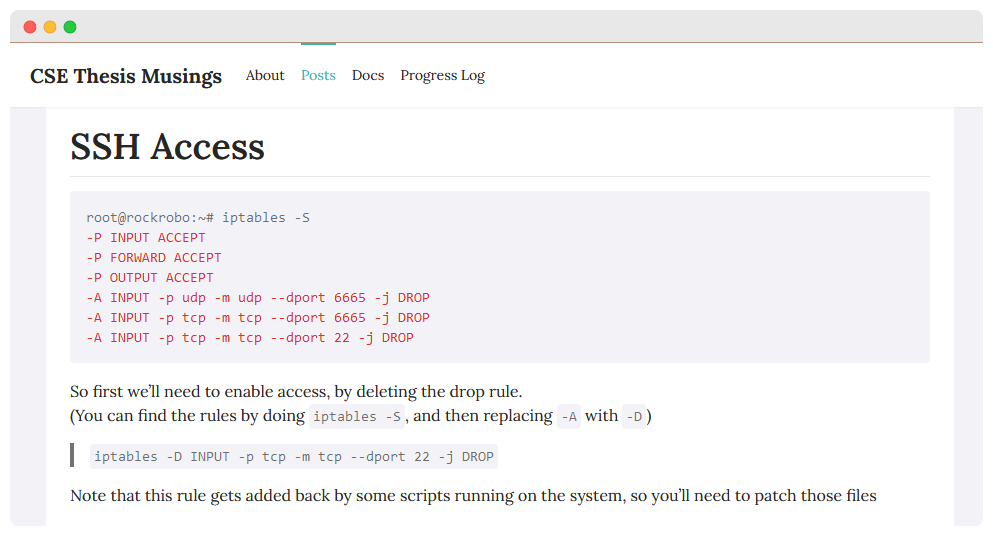
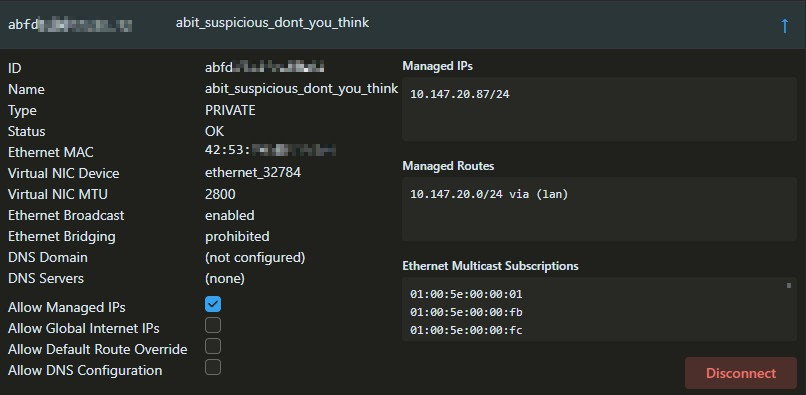
- Remove iptables rule to gain access
- (and so could an attacker)
- Can I add persistent access?
- Yes, modify
rrwatchdoge.conf
- Yes, modify
- Can also add remote access
- 👈 e.g. ZeroTier
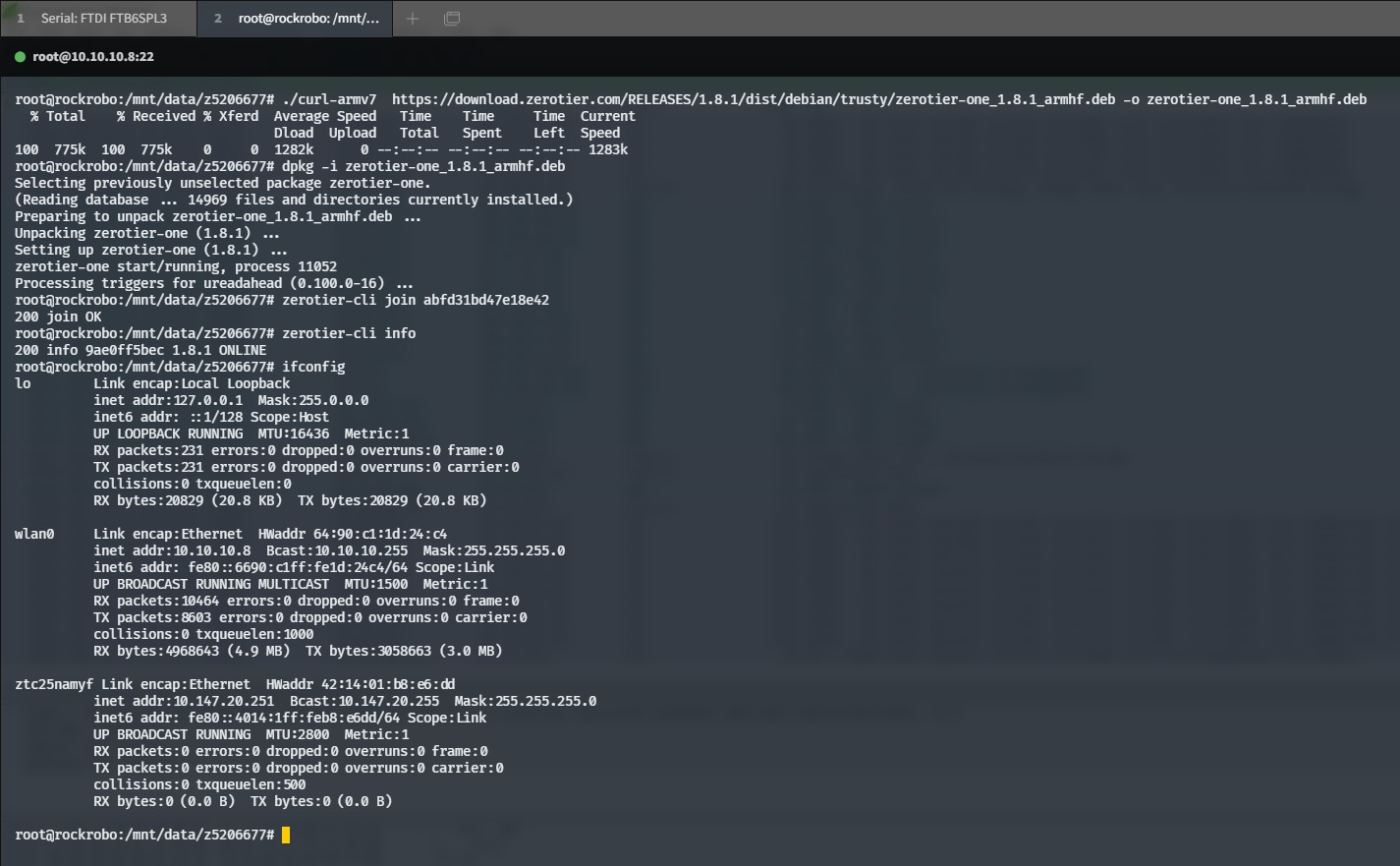
Trivial Power Analysis
Batteries don’t last forever!
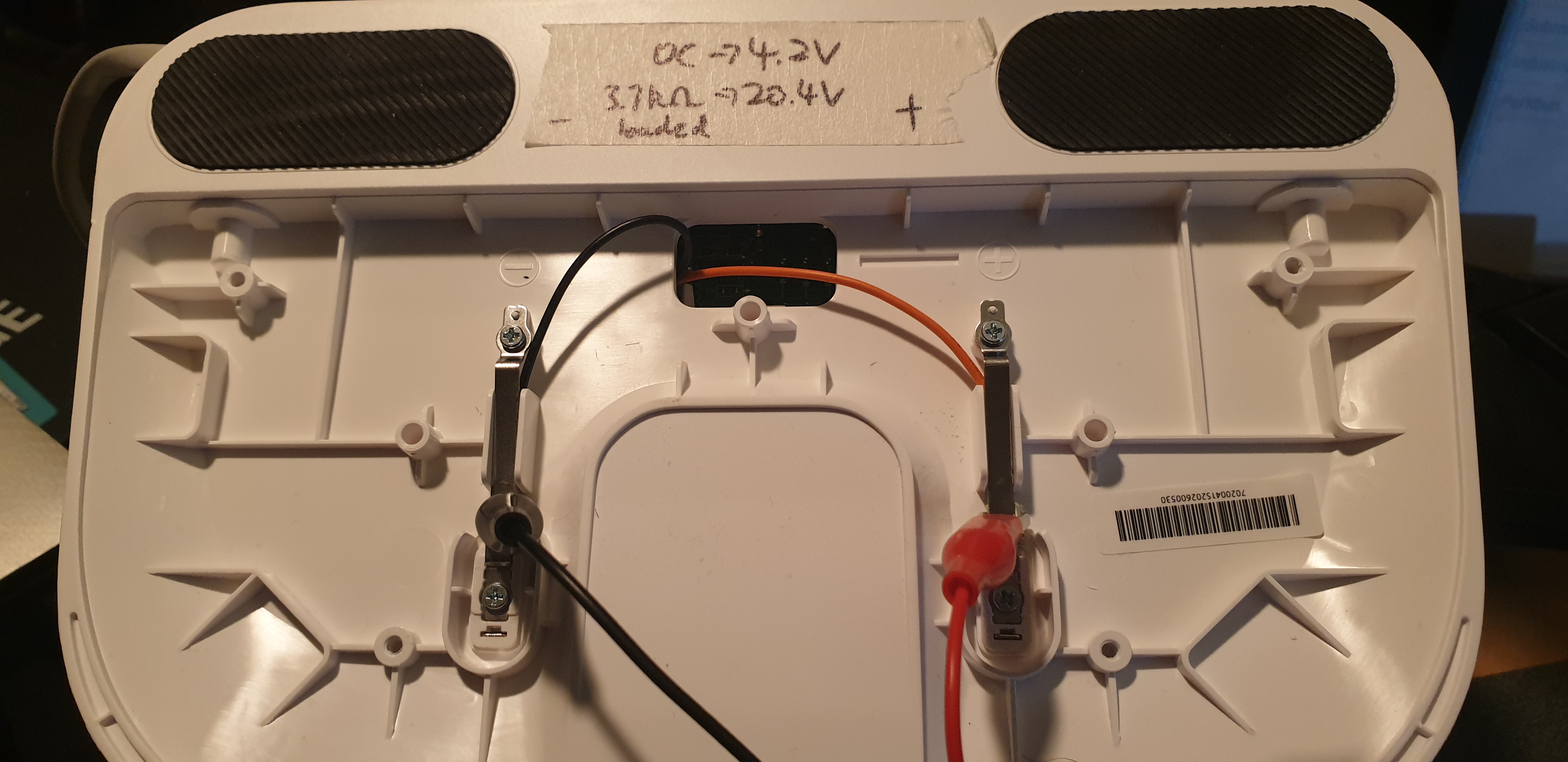
Test: What if I unplug the battery?
- No change in output during boot
- But device will turn off after around 20 seconds
Ubuntu 14.04.3 LTS rockrobo ttyS0
rockrobo login: #### Usual login prompt
wait-for-state stop/waiting
haveged: haveged Stopping due to signal 15 #### Shutdown SIGTERM
* Stopping rsync daemon rsync [ OK ]
* (not running)
* Asking all remaining processes to terminate... [ OK ]
* All processes ended within 1 seconds... [ OK ]
umount: /tmp: device is busy.
(In some cases useful info about processes that use
the device is found by lsof(8) or fuser(1))
* Unmounting temporary filesystems... [fail]
* Deactivating swap... [ OK ]
* Unmounting local filesystems... [ OK ]
* Will now halt
[ 26.948171] [MCU_UART] sent ap poweroff event to mcu #### Device turns off
See 2-wire log, 4-wire log
File System Imaging
The eMMC only has 4GB of storage, so we can’t (also shouldn’t) image the flash onto itself… but we can image it remotely!
IP=10.10.10.8
for partition in `ssh root@$IP "ls /dev/mmcblk0?* -1"`
do
ssh root@$IP "sudo dd if=$partition bs=1M" | dd of=$(basename $partition).img
done
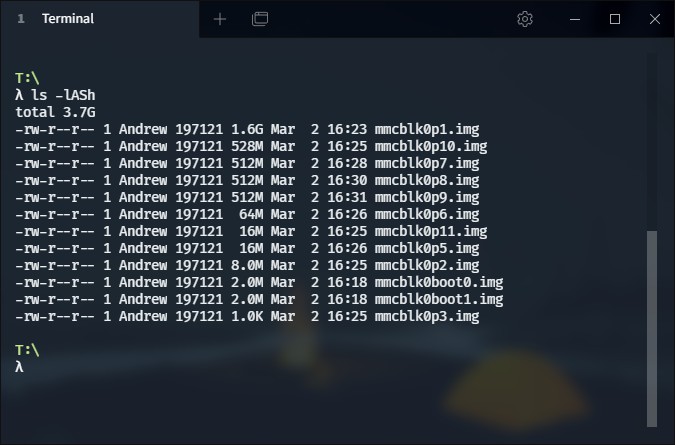
File System Structure
| partition | label | size | description |
|---|---|---|---|
| mmcblk0p1 | UDISK | 1.5 GB | user data |
| mmcblk0p2 | boot-res | 8 MB | bootloader stuff |
| mmcblk0p5 | env | 16 MB | |
| mmcblk0p6 | app (RO) | 64 MB | device data |
| mmcblk0p7 | recovery | 512 MB | stock firmware |
| mmcblk0p8 | system_a | 512 MB | Main OS (boot) |
| mmcblk0p9 | system_b | 512 MB | Backup OS |
| mmcblk0p10 | Download | 528 MB | Update temp |
| mmcblk0p11 | reserve | 16 MB | blackbox??? |
Recovery Reset
Recovery supposedly resets system_a, system_b, UDISK and Download

- What about the other partitions?
- Can we install software in the
recoverypartition? 🚩

28,189 files…
Well there’s for sure a lot of files to look at…
I did a thing - Commentree
Plain-text annotation / commentary tool
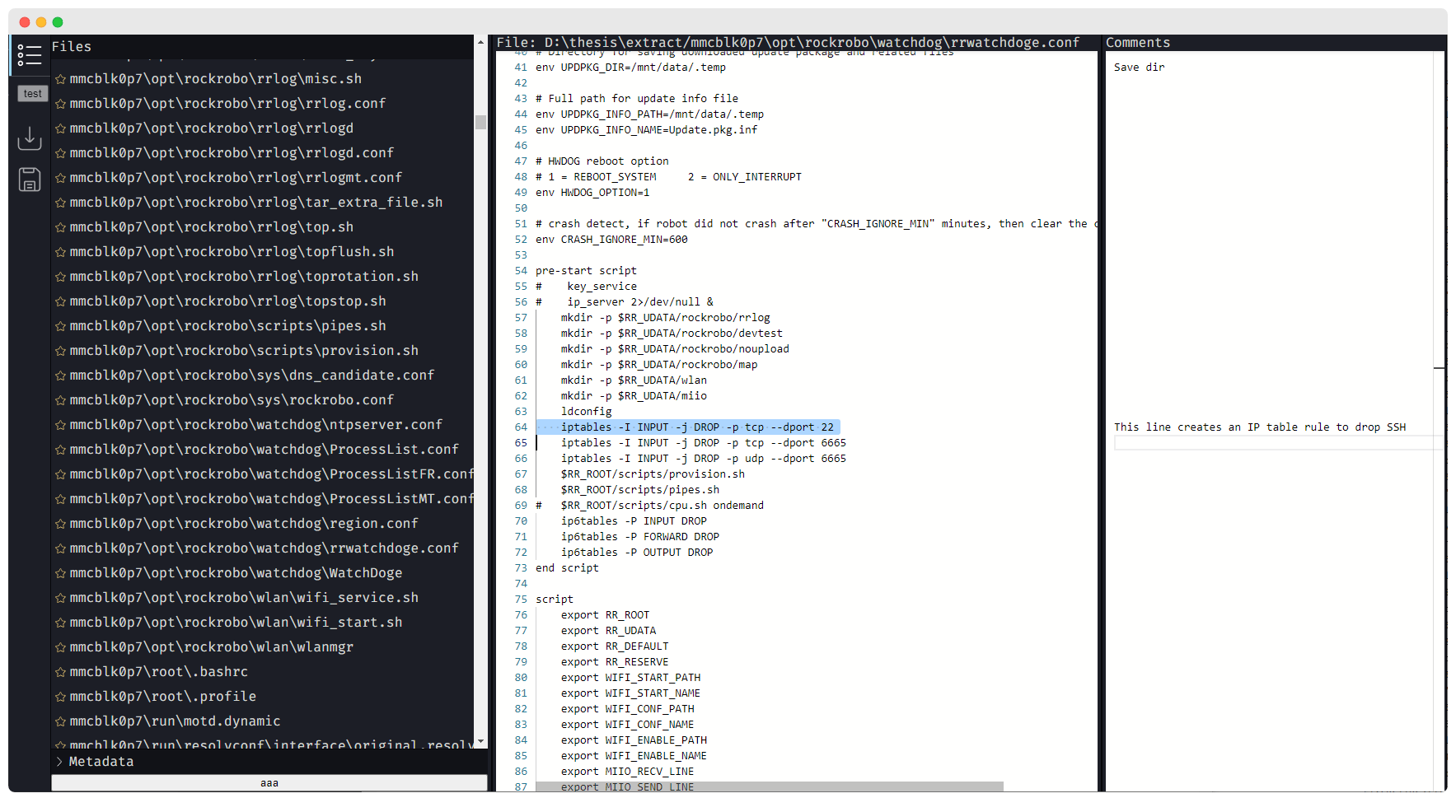
(some) Interesting Files
The Search
- Looked for any passwords, secrets, keys, IDs, function calls, logs, …
- Find changed files (*)
- See where they are used
- See how they are used
- Anything of general interest
- mmcblk0p1
- miio/device.token
- miio/device.uid
- rockrobo/
- rockrobo/rrlog/ (logs are encrypted!)
- mmcblk0p8/opt/rockrobo
- Binaries
- scripts/pipes.sh
- rrlog/misc.sh
- mmcblk0p11/endpoint.bin - AWS address + key?
mmcblk0p8/opt/rockrobo/rrlog/misc.sh
...
#echo "=======device.conf==========" >> /dev/shm/misc.log
#cat /mnt/default/device.conf >> /dev/shm/misc.log
...
mmcblk0p6/device.conf
did=DDDDDDDDD # (9 digits)
key=XXXXXXXXXXXXXXXX # (16 alpha-num, case-sensitive)
mac=64:90:C1:1D:24:C4
vendor=roborock
model=roborock.vacuum.s6
Calls for
system
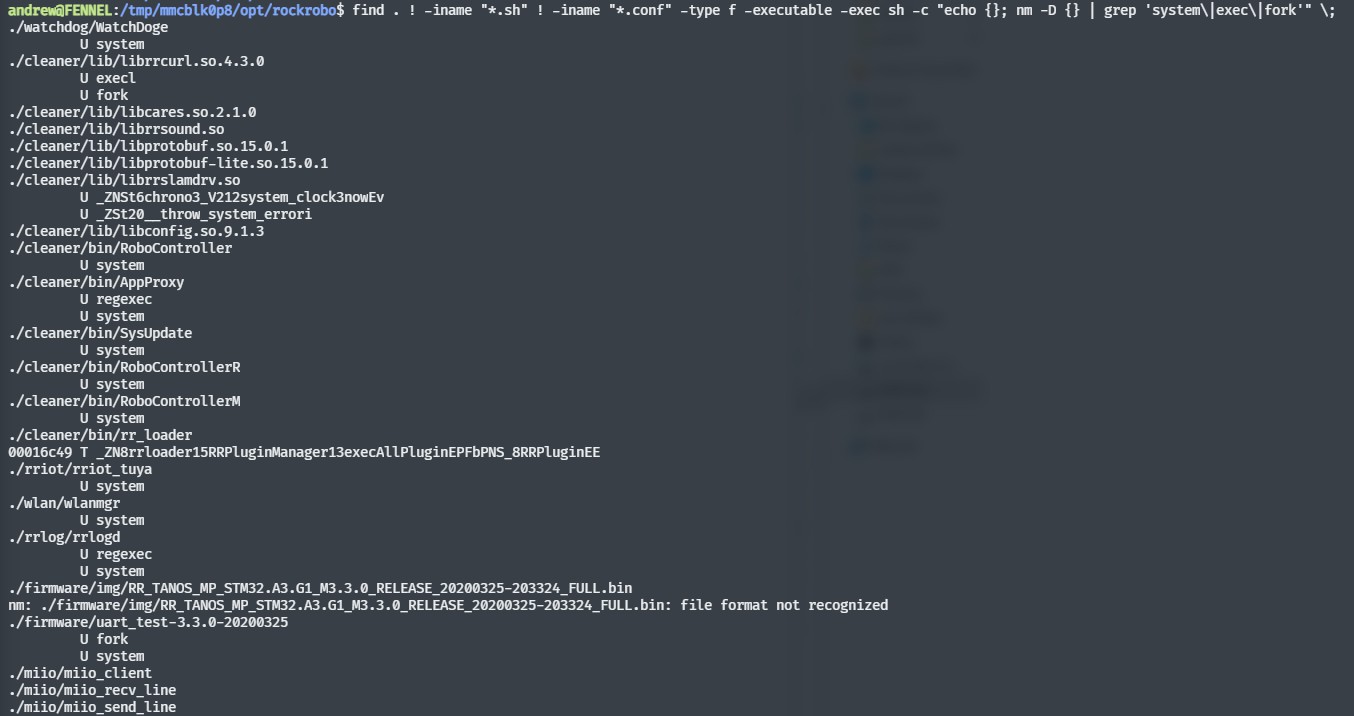
/var/log/apt/history.log
Installed packages that are not part of the base system
Start-Date: 2016-01-25 11:18:05
Commandline: /usr/bin/apt-get install rsync
Install: rsync:armhf (3.1.0-2ubuntu0.2)
End-Date: 2016-01-25 11:18:11
Start-Date: 2016-04-05 12:30:59
Commandline: /usr/bin/apt-get install ccrypt
Install: ccrypt:armhf (1.10-4)
End-Date: 2016-04-05 12:31:01
Start-Date: 2016-04-25 09:58:29
Commandline: /usr/bin/apt-get install tcpdump
Install: tcpdump:armhf (4.5.1-2ubuntu1.2), libpcap0.8:armhf (1.5.3-2, automatic)
End-Date: 2016-04-25 09:58:33
- Why does a vacuum cleaner need
rsyncortcpdump? - No usage calls found yet
mmcblk0p7/usr/sbin/tcpdump
- External but unmodified binary
- Only hub traffic visible (wireless)
- (not really that interesting)

mmcblk0p8/opt/rockrobo/rrlog/rrlogd
✅ Logs are encrypted at rest (after being packed)
✅ Originally used to be a symmetric key, now using a public key
😕 Logging program has the functionality to unblock port 22?
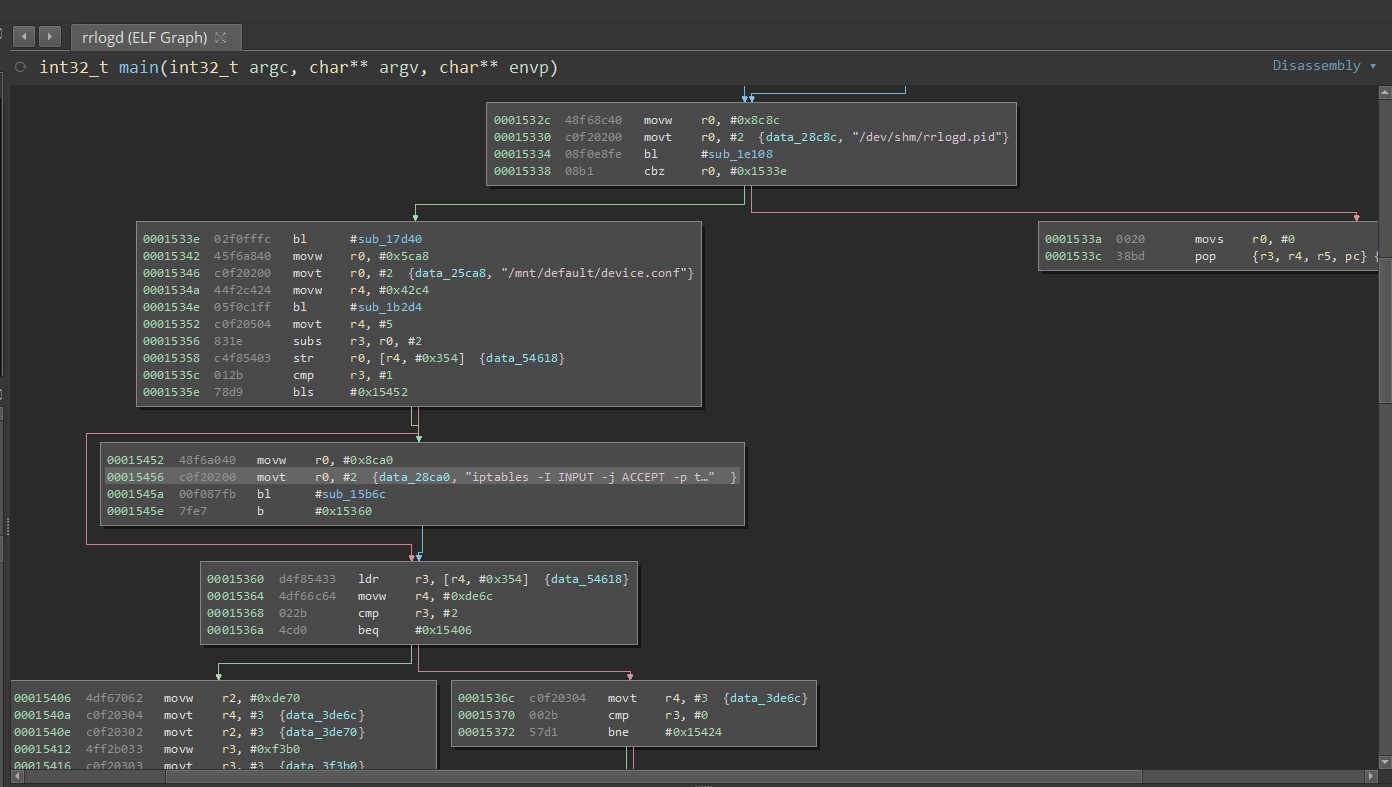

iptables -I INPUT -j ACCEPT -p tcp --dport 22
mmcblk0p6/vinda
Previously… XOR this file to get the root password

mmcblk0p7/usr/bin/adbd
- Custom ADB binary
- Had a brief look (more)
locksec_init_key: can not find the prefix str from adb conf file, use default
locksec_init_key: can not find the suffix str from adb conf file, use default
locksec_init_serial: adb read 465 bytes from /proc/cpuinfo
locksec_init_key: locksec_init_key, rockrobo%()+-[]_8a80ab8936d76c118000:;<=>?@{}rubydevicemodel
locksec_apply_key: locksec_apply_key, erI09cyW%()+-[]_8a80ab8936d76c118000:;<=>?@{}CzD2xuMNlwabTK7
locksec_apply_passwd: adb source str: erI09cyW%()+-[]_8a80ab8936d76c118000:;<=>?@{}CzD2xuMNlwabTK7
locksec_apply_passwd: locksec_apply_passwd, passwd: 0y[ad8@w
- mmcblk0p6/vinda
- mmcblk0p6/adb.conf
- mmcblk0p8/var/log/upstart/adbd.log
Future: the other programs
- cleaner
- miio
- rockrobo
- rrlog
- rriot
Issues, thoughts & discussions
How have manufacturers of IoT / smart home devices addressed the increasing concerns of digital privacy and product security?
🚩 Wireless credentials are stored in plain text
- Anyone with access to the machine can gain wireless credentials
- However, takes a lot of effort to open up the device
- Why?
wpa_supplicantis part of the underlying Linux framework
⚠️ SSH server exposed on
tcp/22
- Why does this server exist?
- When / where is it used?
- Allow rule inside the
rrlogdbinary
- Allow rule inside the
- Roborock has made an attempt to protect their product with
iptables - But did not fully product their product against access via IPv6
🚩 Processes are running as
root
- Any vulnerability in any of the programs can result in elevated access
- Dropping of iptables restrictions
- Persistence planting
- System takeover
- Should run as a de-privileged user
- Why? Compatibility, perhaps ease of development
- i.e.
udevrules
- i.e.
🚩 Recovery partition is modifiable
- Can be modified to contain malicious software that persists a factory reset
- Mountable -
mount /dev/mmcblk0p7 ... - Why? Allows easy updates of the ‘factory image’
- But the partition could somehow be encrypted
access to the hardware = game over?
- Are there tamper-proof / tamper-evident design possibilities?
- What about some sort of “Secure Element”
- Or read protection?
- Choice of OS
- Choice of auth implementation (e.g.
vinda) - Limitation on what programs are allowed to execute?
✅
- An effort to restrict SSH access via
iptables - AuthN / AuthZ is present within interfaces to the device
- UART shell requires a password
- Logs are encrypted locally
Current Challenges
Intercepting encrypted data / TLS traffic
- Ubuntu 14.04 has some issues (?)
PolarProxyis too new (libc requirements)- apt update doesn’t work with socks5:// or http proxies properly???
- Routing?
- Hook into the encryption/decryption process somehow?
- Use
Frida? - Or look at the data communicated by the smartphone app?
Objectiontool didn’t work with the RoboRock app
- Use
Electricity is funny.
Using my main personal computer is not a good idea for a test-bench…
👏 Thank you Gigabyte for having ESD-protected USB ports

Still a lot of files to look at
Need to figure out which files are worthwhile to inspect..
Ubuntu 14.04.3 LTS was released back in 2014, any changes would have a later timestamp (hopefully)
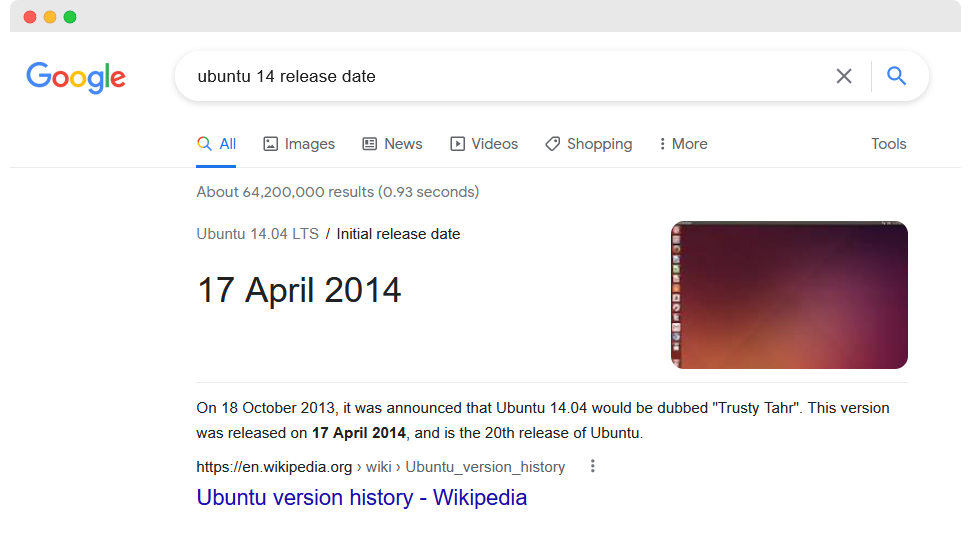
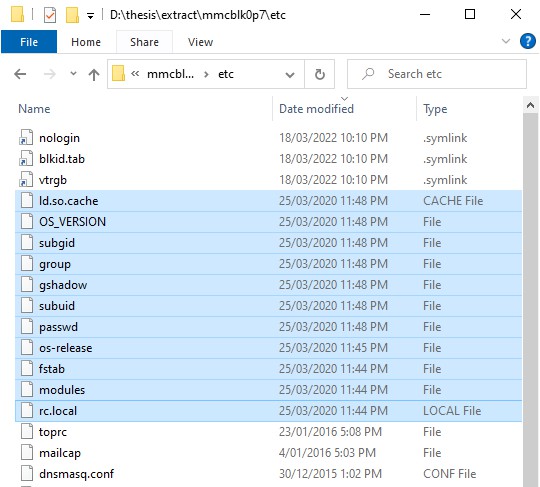
Thesis B Retrospective
- Time management - could have done more work
- Busy / other commitments
- Hardware work restricts me to only working at home
- Project breadth / depth / scope
- Binary analysis takes a lot of time
- Schedule more focus times
- Hardware work pretty much completed - likely able to work remotely now
- Restrict binary analysis to the most likely binaries
- May consequently miss something
- Analysis of firmware binaries to identify vulnerabilities
- Still in progress
- Search for unsecured secrets, logs, configurations
- Completed (excluding encrypted
rrlogfiles)
- Completed (excluding encrypted
- (priority) Inspection of outbound WAN traffic - security, PII, etc
Inspection of LAN trafficrather, see if it is storedInspection of interaction with nearby devicesProtocol analysis- Update to a newer firmware version and look at changes
- Check what files gets cleared during a format
- Binary assessment
- Verify IPv6 SSH access
Incoming Timeline
- - IPv6 SSH verification, continue binary assessment
- - WAN traffic analysis
- Look at network behaviour
- Try view WAN data pre-encryption / post-decryption
- - Update to latest version (and hope we don’t get locked out)
- Do another vacuum clean, reimage, compare binaries
- - Factory reset device, check for remnant files
- - Demo submission
- - Report submission
Thank You
Andrew Wong
w: featherbear.cc/UNSW-CSE-Thesis
e:
